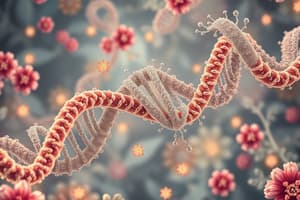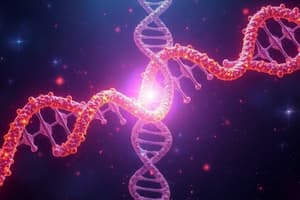Podcast
Questions and Answers
If a mutation occurs where a single nucleotide base is replaced with another, which type of mutation is this?
If a mutation occurs where a single nucleotide base is replaced with another, which type of mutation is this?
- Frameshift
- Deletion
- Substitution (correct)
- Insertion
During DNA replication, which enzyme is responsible for joining Okazaki fragments on the lagging strand?
During DNA replication, which enzyme is responsible for joining Okazaki fragments on the lagging strand?
- Helicase
- Primase
- Ligase (correct)
- DNA Polymerase
In protein synthesis, what is the role of tRNA?
In protein synthesis, what is the role of tRNA?
- Carries genetic information from DNA to ribosomes
- Forms part of ribosomes and helps assemble proteins
- Unwinds the DNA helix
- Brings amino acids to ribosomes during translation (correct)
If a DNA sample contains 20% guanine (G), what percentage of adenine (A) would you expect to find in the same sample, according to Chargaff's rule?
If a DNA sample contains 20% guanine (G), what percentage of adenine (A) would you expect to find in the same sample, according to Chargaff's rule?
Which of the following is a key difference between DNA and RNA?
Which of the following is a key difference between DNA and RNA?
During transcription, which enzyme is responsible for reading the DNA sequence and synthesizing mRNA?
During transcription, which enzyme is responsible for reading the DNA sequence and synthesizing mRNA?
Which of the following best describes the function of a gene?
Which of the following best describes the function of a gene?
What is the significance of the anticodon region on tRNA molecules?
What is the significance of the anticodon region on tRNA molecules?
Which of the following mutations is MOST likely to cause a significant change in the resulting protein?
Which of the following mutations is MOST likely to cause a significant change in the resulting protein?
What is the correct mRNA sequence transcribed from the following DNA sequence: 5'-TACGCT-3'?
What is the correct mRNA sequence transcribed from the following DNA sequence: 5'-TACGCT-3'?
If you perform gel electrophoresis on DNA fragments, what property of the fragments determines their rate of migration through the gel?
If you perform gel electrophoresis on DNA fragments, what property of the fragments determines their rate of migration through the gel?
Which of the following best describes the function of PCR (Polymerase Chain Reaction)?
Which of the following best describes the function of PCR (Polymerase Chain Reaction)?
A mutation that arises from exposure to UV radiation is classified as what type of mutation?
A mutation that arises from exposure to UV radiation is classified as what type of mutation?
Which of the following is NOT a step in protein synthesis?
Which of the following is NOT a step in protein synthesis?
What is the central dogma of molecular genetics?
What is the central dogma of molecular genetics?
During DNA replication, what is the role of the enzyme helicase?
During DNA replication, what is the role of the enzyme helicase?
In protein synthesis, where does the process of translation take place?
In protein synthesis, where does the process of translation take place?
A mutation that does not result in a change in the amino acid sequence of a protein is called a:
A mutation that does not result in a change in the amino acid sequence of a protein is called a:
Which technology allows scientists to precisely edit genes in living cells?
Which technology allows scientists to precisely edit genes in living cells?
Within the structure of DNA, how do the nitrogenous bases pair?
Within the structure of DNA, how do the nitrogenous bases pair?
Flashcards
Central dogma of genetics
Central dogma of genetics
Genetic information flows from DNA → RNA → Protein, involving transcription (DNA to RNA) and translation (RNA to protein).
DNA structure
DNA structure
A double-stranded molecule forming a double helix, with sugar-phosphate backbones and paired nitrogenous bases (A-T, C-G).
Chargaff’s rule
Chargaff’s rule
In DNA, Adenine (A) pairs with Thymine (T), and Cytosine (C) pairs with Guanine (G).
Gene
Gene
Signup and view all the flashcards
DNA vs. RNA
DNA vs. RNA
Signup and view all the flashcards
Key DNA replication enzymes
Key DNA replication enzymes
Signup and view all the flashcards
Leading vs. lagging strand
Leading vs. lagging strand
Signup and view all the flashcards
Types of RNA
Types of RNA
Signup and view all the flashcards
Protein synthesis
Protein synthesis
Signup and view all the flashcards
tRNA binding
tRNA binding
Signup and view all the flashcards
Mutation types
Mutation types
Signup and view all the flashcards
Spontaneous vs. induced mutations
Spontaneous vs. induced mutations
Signup and view all the flashcards
Neutral/silent mutations
Neutral/silent mutations
Signup and view all the flashcards
Gel electrophoresis
Gel electrophoresis
Signup and view all the flashcards
PCR and CRISPR
PCR and CRISPR
Signup and view all the flashcards
Study Notes
- Central dogma of genetics describes the flow of genetic information: DNA → RNA → Protein
- This process includes transcription (DNA to RNA) and translation (RNA to protein).
DNA Nucleotide Structure
- Consists of a phosphate group, a deoxyribose sugar, and a nitrogenous base
- Nitrogenous bases include Adenine, Thymine, Cytosine, or Guanine
DNA Structure
- DNA is double-stranded and forms a double helix
- Sugar-phosphate backbone runs along the outside of each strand
- Nitrogenous bases pair in the middle, like rungs on a ladder (A with T, and C with G)
Chargaff’s Rule
- In DNA, Adenine (A) equals Thymine (T), and Cytosine (C) equals Guanine (G)
- Complementary bases pair specifically: A with T, and C with G
Calculating Base Percentages
- If a DNA sample has 8% A, then it also has 8% T
- The remaining percentage is split between C and G
- With 8% A and 8% T, C = 42% and G = 42%
Genes
- Genes are segments of DNA that contain instructions for making a specific protein or RNA molecule
- Genes serve as the basic unit of heredity
DNA vs. RNA
- DNA has deoxyribose sugar, while RNA has ribose sugar
- DNA uses thymine (T), while RNA uses uracil (U)
- DNA is double-stranded, while RNA is single-stranded
- DNA is more stable than RNA
Enzymes in DNA Replication
- Helicase unwinds the DNA helix
- Primase synthesizes RNA primers
- DNA Polymerase adds nucleotides to form new strands
- Ligase joins Okazaki fragments on the lagging strand
Leading vs. Lagging Strand
- The leading strand is synthesized continuously in the direction of replication
- The lagging strand is synthesized discontinuously in short fragments called Okazaki fragments
Complementary DNA Strand
- Original sequence: ATCGGGAGAGCTACGACGTTAGCGATACGTACGTACGTTTAAAGC
- Complementary strand: TAGCCCTCTCGATGCTGCAATCGCTATGCATGCATGCAAATTTCG
Types of RNA
- mRNA (messenger RNA) carries genetic information from DNA to ribosomes
- tRNA (transfer RNA) brings amino acids to ribosomes during translation
- rRNA (ribosomal RNA) forms part of ribosomes and helps assemble proteins
Protein Synthesis
- RNA polymerase reads DNA to make mRNA during transcription
- mRNA travels from the nucleus to ribosomes
- Ribosomes read mRNA codons during translation
- tRNA brings amino acids matching mRNA codons
- Amino acids link into a polypeptide chain
- The polypeptide folds into a functional protein
mRNA Transcription
- DNA sequence: ATCGGGAGAGCTACGACGTTAGCGATACGTACGTACGTTTAAAGC
- mRNA sequence: UAGCCCCUUCAGUGCCAUCGCUAUGCAUGCAUGCAAUUUCG
- Codons: UAG CCC CUU CAG UGC CAU CGC UAU GCA UGC AUG CAU UUU CG
tRNA Binding
- tRNA has an anticodon region that is complementary to mRNA codons
- This ensures proper base pairing
Types of Mutations
- Substitution: One base is changed (e.g., ATCGGG → ATCGTG)
- Insertion: An extra base is added (e.g., ATCGGG → ATCGTGGG)
- Deletion: A base is removed (e.g., ATCGGG → ATCGG)
Spontaneous vs. Induced Mutations
- Spontaneous mutations occur naturally during replication
- Induced mutations result from environmental factors like UV radiation, chemicals, or X-rays
Neutral Mutations
- Some mutations do not affect protein function because they occur in non-coding regions
- Mutations might result in synonymous codons that code for the same amino acid
Gel Electrophoresis
- DNA fragments are placed in a gel
- An electric current pulls DNA towards the positive end
- Smaller fragments move faster, separating by size
- Bands are visualized under UV light or staining
Molecular Biology Techniques
- PCR (Polymerase Chain Reaction) rapidly amplifies DNA sequences for analysis
- CRISPR precisely edits genes by targeting specific DNA sequences
- These techniques revolutionized genetic research, diagnostics, and gene editing
Genetic Engineering Example
- Glow-in-the-dark cats using jellyfish genes encoding Green Fluorescent Protein (GFP)
- Species: Domestic cats
- Purpose: Study genetic disease resistance
- Techniques used: Gene insertion via viral vectors
- Effects: Cats glowed under UV light without harm
Studying That Suits You
Use AI to generate personalized quizzes and flashcards to suit your learning preferences.




